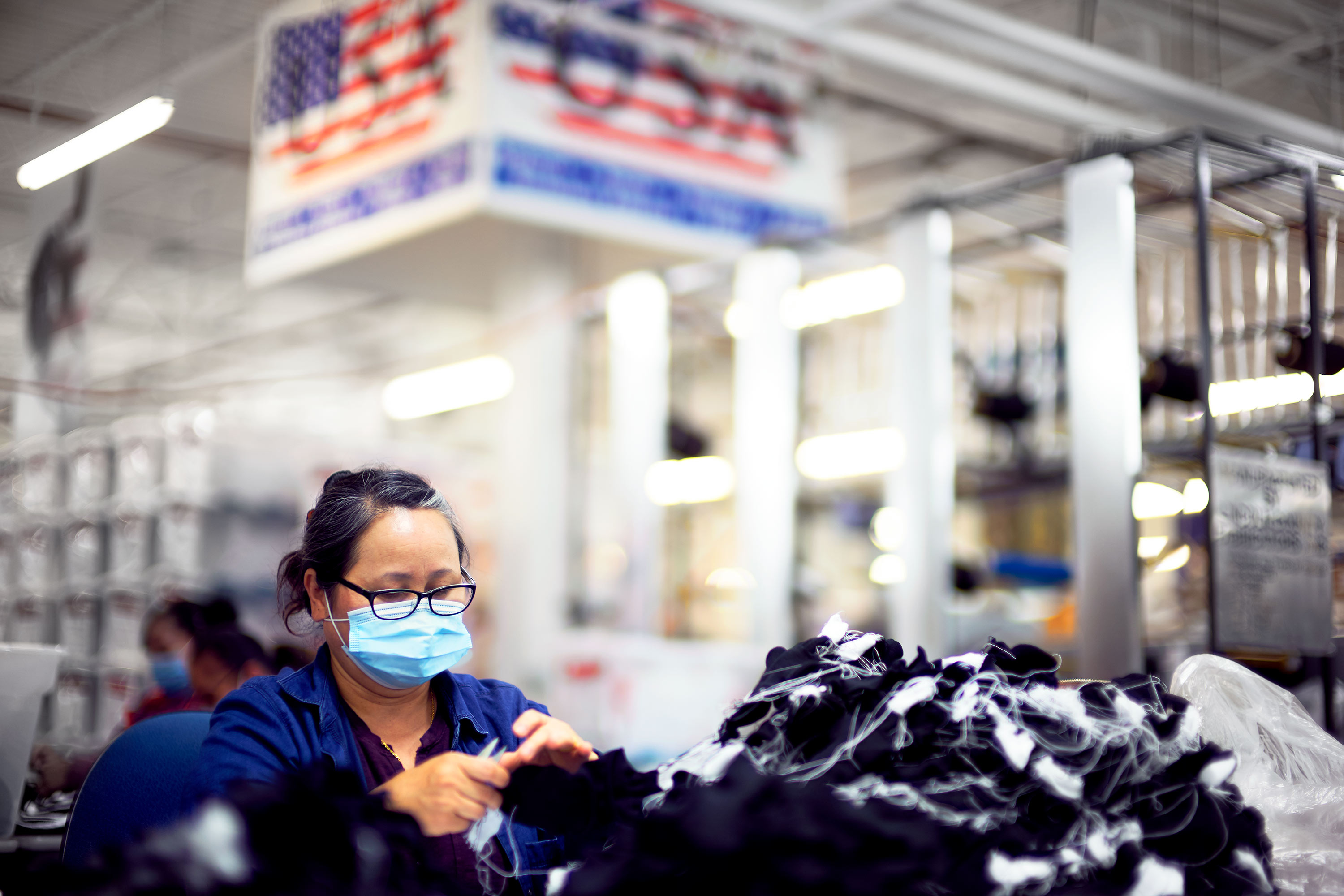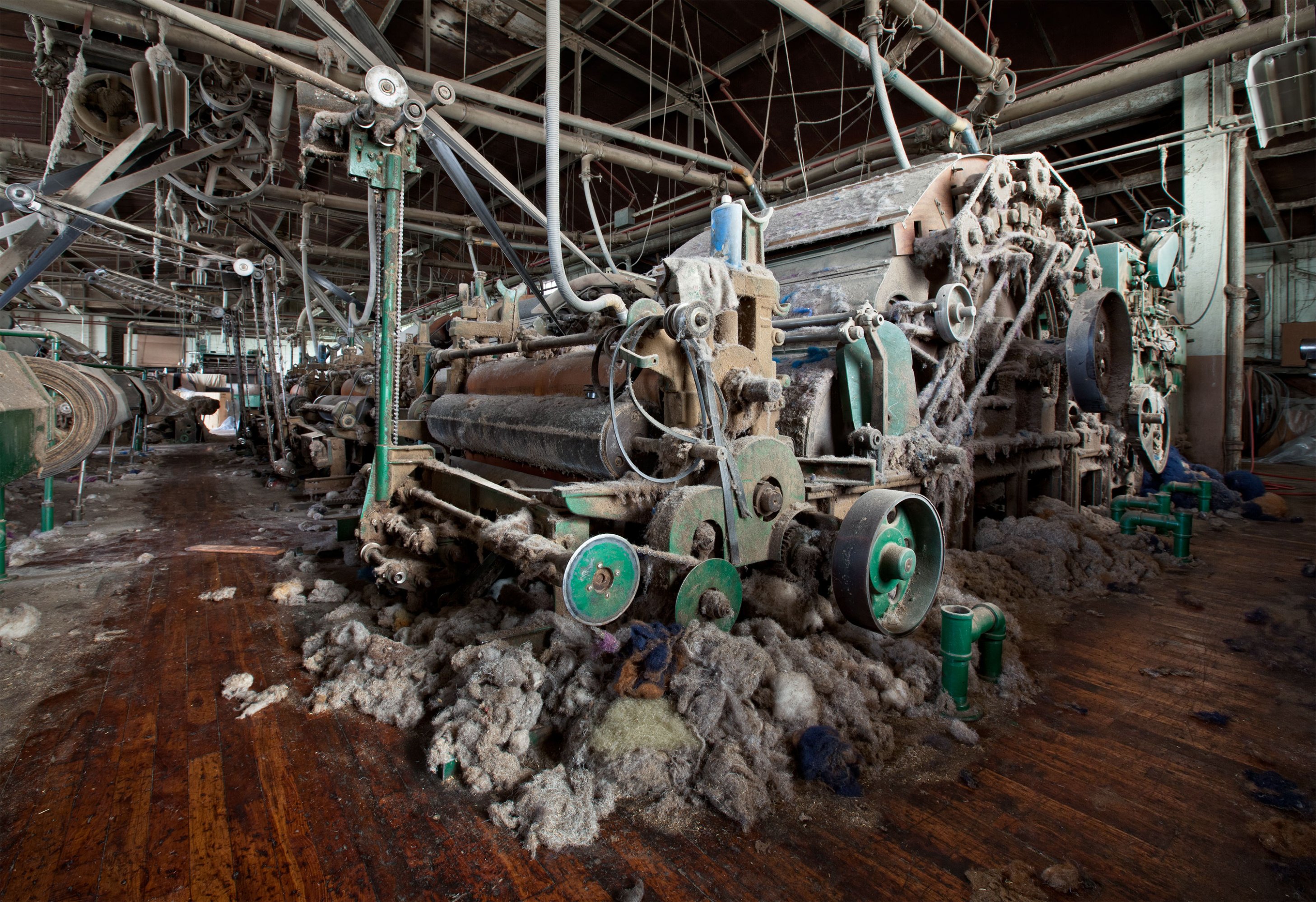In July, St. Louis was still scrambling to raise $500,000 to buy machinery that would allow him to test the fabric used in masks. Meanwhile, he refers inquiries about mask testing to a company in Nevada–the lone private laboratory in the US certified by the CDC to perform such tests.
Meanwhile, 40 miles south of Conover, in the town of Belmont, the Textile Technology Center at Gaston College specializes in what the industry refers to as “yarn.” Give Dan Rhodes a small sample of a novel polymer, and he’ll figure out how to extrude it into a filament, and how to fine-tune the process to see whether the material can be made to work in high-speed manufacturing. Rhodes and his colleagues are working with a manufacturer of coronavirus test kits to make the fiber wicks that siphon saliva samples into a blend of testing reagents. Another client is an Ohio-based manufacturer of cotton swabs that is replacing the cotton with a synthetic equivalent in order to make nasal testing swabs uncontaminated by the plant fiber’s DNA.
Vital work. And yet in each case, few American businesses could step up to fill a similar niche. Rhodes told me that most surviving textile companies have long since disbanded the proprietary sampling labs they used to house on site. Many of the senior staff at both centers learned their trade at companies that were picked apart and reconstituted overseas after hostile takeovers by investors like Wilbur Ross, the current secretary of commerce, who made part of his fortune outsourcing textile jobs to Asia in the early 2000s.
That means much of the brain trust for the American textile industry–the Manufacturing Solutions Center’s website advertises “300 years of textile experience”–got its training in private-sector jobs that no longer exist in the United States. Rhodes, who is 72, plans to retire at the end of August and jokes that “half the people here collect a Social Security check.” St. Louis retired in July; every plant where he ever worked closed long ago.
Rhodes recalls watching from afar as the town of Fort Payne, Alabama, lost its status as “sock capital of the world.” “All it takes is one financier“–he stretches the word across four venomous syllables–“on Wall Street to call somebody in China and say, ‘Send me a million dozen of those black socks with the gold thread in the toe.’ He doesn’t know how to make any socks, but he can destroy all that expertise.”
Why did the sock makers leave Fort Payne? To Jon Clark, who spent 30 years crisscrossing the country from his home in Houston to buy scrap equipment from shuttered factories, the answer is obvious: there’s money to be made shifting operations from what he calls “the 30-, 40-, 50-dollar-an-hour zone in the US” to the “three-, four-, five-dollar zone” overseas. The problem, in Clark’s view, is that the incentives driving the economy no longer distinguish between profitability and greed. “It used to be that plants closed because they weren’t profitable,” he says. “Now they close because they’re not profitable enough.”
Clark, who is 72, began his career in 1965 as an engineer in a Texas fertilizer plant where chemically induced asthma was a daily hazard. He remembers watching birds expire in midair as they flew from one side of the plant to the other. Environmental laws transformed huge swaths of American manufacturing, but they also gave US corporations a strong incentive to relocate factories to places where they could pollute at will.
Over the same period, seismic improvements in shipping and technology made it possible for corporations to rely on networks of suppliers that stretch across the planet. Modern supply chains are fluid and elaborate, ever shifting to account for minute changes in the price of screws, thread, or copper wire. As a result, manufacturers have continued to bring cheaper goods to American consumers even as the components required to make them come from farther and farther away.
“Can you imagine a plant that does nothing but break a million eggs a month? That’s 500 tons of broken shells a year!”
Jon Clark, publisher of Plant Closing News
Clark began buying and selling equipment full time in the 1980s, just as these transformations were accelerating the exodus of heavy manufacturing from the US to cheaper labor markets all over the world–China, Mexico, Vietnam. In 2003, he began publishing a biweekly newsletter called Plant Closing News (PCN) as a service for the scrap industry, a way to help auctioneers and equipment brokers chase leads on bargain wire stranders and double-arm mixers across the country. Over the years, his encyclopedic knowledge of the decline–or, more charitably, the evolution–of American industry has crystallized into a kind of lament about the shifting character of the US economy.
Each PCN listing includes the type of facility and its expected closing date, an address, a phone number, and the name of a contact person for anyone looking to move, buy, or scrap the equipment inside, along with a sentence or two on the number of displaced workers and the reasons behind a plant’s shuttering. Compiling the entries is simple, if grueling, work that usually involves extracting the necessary particulars over the phone from employees likely to be losing their jobs. By the time Clark sent out the last issue in December 2019, after a detached retina left him temporarily blind in one eye, he had chronicled the demise of 16,000 factories, plants, and mills in 17 years.
When Clark and I first spoke, he began reading his newsletter aloud to me over the phone in a rich Texas baritone, interspersed with his own idiosyncratic commentary. “Can you imagine a plant that does nothing but break a million eggs a month?” he asked. “That’s 500 tons of broken shells a year!”

COURTESY PHOTO
Clark rattled off all the factory closures he’d compiled for a stretch of July 2019: an aircraft-lock assembly plant, a scrap-metal shredding facility, a conveyor manufacturer, three plastic-bottle plants, a foundry, a glass plant, a South Carolina plant that manufactured textile machinery, a pharmaceutical plant in Wyoming (“The only one,” he interjected), a Florida plant that bent tubes into automotive parts, a paint-manufacturing plant in Missouri, a corrugated-cardboard-box plant in New York, and on and on and on. “Those are the ones that I know of,” Clark added, when he finally reached the end of the list.
The decision to close a plant often heralds a chaotic time on the ground, as a dwindling team on site shoulders the responsibility of continuing to run a facility slated for closure. There’s still inventory to track, maintenance to be done, and product to be pushed out, along with all the paperwork that goes into settling the books before closing a place down. Often, the workers themselves are the last ones to be told.
For the first five years of PCN, Clark’s daughter Kristen, then at home with her oldest child, was his main “caller.” She took the leads he gleaned from trade publications and industry chatter, contacted the plants, and coaxed the remaining staff into providing the information needed for Rolodex-like entries designed to help contractors gin up business in demolition, secondhand equipment, and environmental remediation. “We got hung up on a lot,” Kristen remembers. But there were also moments of pathos. “We got an opportunity to cry with them, and pray with them, and a lot of them got very angry,” Jon says.
PCN’s run overlapped with a historic decline in manufacturing employment in the United States. From 2000 to 2016, the US shed nearly 5 million manufacturing jobs, or more than a quarter of the total, and one out of every five manufacturing establishments in the country shut its doors. Clark charted this decline in his newsletter, watching as globalization tugged at one thread after another in the tapestry of American industry. In the early 2000s, a wave of sock manufacturers closed, followed by food-processing plants, plastics plants, automotive plants, and lightbulb factories.

CHRIS EDWARDS
In 2013, Walmart rolled out a “Made in the USA” campaign, vowing to shore up domestic manufacturing by spending $50 billion over 10 years on US-made goods. But the company was forced to scale back its ambitions after the watchdog group Truth in Advertising found hundreds of products at Walmart stores falsely labeled as made in the USA. As Clark put it, “We still have 330 million people in this country, most of whom wear socks, but Walmart couldn’t find anybody who made socks in America.”
Five years ago, Donald Trump campaigned on the argument that manufacturers who offshored American jobs were forsaking patriotism for profit. Fused with racist grievance and conspiracy theory, that message helped propel him to the Republican nomination and then the presidency. In the 2016 election, Trump’s attacks on corporations that “moved [our] jobs to Mexico” were a core element of his pitch to the very same voters–white, male Midwesterners with a high school education–who formed a prominent cohort in America’s shrinking manufacturing workforce.
At the time, the prevailing wisdom among economists held that Trump was wrong. Certainly, previous declines in American manufacturing, such as the waves of textile and steel layoffs in the 1980s, could be linked more or less directly to gains in developing countries. Hundreds of new garment factories opened in China, Bangladesh, and Indonesia. Brazil and South Korea aggressively expanded steel production. But while the decline in the 2000s appeared to have a similar explanation–now China’s and South Korea’s economies were expanding by leaps and bounds, and American stores were filling with Korean TVs and Chinese toys and electronics–many economists and commentators looked at the data on manufacturing’s share of GDP and concluded that imports couldn’t be the major culprit behind so many lost jobs.
A typical example: Michael Hicks, an economist at Ball State University, coauthored a widely cited report arguing that “import substitution”–Americans’ choices to buy cheaper foreign-made products instead of more expensive goods made domestically–accounted for only about 750,000 lost jobs, or roughly one-seventh of the total. What took away the rest? Layoffs of redundant workers once protected by unions; robots and automation; and reliance on more efficient maintenance and service contractors in place of part of the former labor force, he argued. After all, even as the number of manufacturing jobs shrank dramatically, the dollar value of US manufactured goods continued to grow. “I call it productivity,” Hicks told me.
For years, Susan Houseman, a labor economist at the Upjohn Institute for Employment in Kalamazoo, Michigan, watched a parade of pundits explain away those 4 million lost jobs in similar terms. Houseman didn’t buy it. Beginning in 2007, she published a series of papers arguing that the basic tools the federal government uses to generate manufacturing, import, and export statistics were misleading and frequently misinterpreted.

MATTHEW CHRISTOPHER
If a television manufacturer that sells $1,000 TVs relocates production overseas, and Americans start buying $500 imported TVs instead, the amount of economic activity “displaced” by offshoring shows up as $500, not $1,000. But the American town that hosted the old factory lost $1,000 worth of work. Even if the TV is still made in the US, but complex components start being sourced abroad, productivity statistics don’t account for labor done by foreign suppliers. If a TV assembled in Ohio takes nine hours of Vietnamese labor and one hour of Toledo labor, as opposed to all 10 hours coming from Toledo, federal statistics will show that American manufacturers are suddenly able to produce 10 times as many TVs with the same amount of labor. “Productivity” jumps. It appears as though technology improved, when what really happened is that jobs were shipped abroad.
Furthermore, Houseman adds, for several decades, the speed and power of the chips and semiconductors churned out by one small slice of American manufacturers advanced so rapidly that increases in “output” from that sector alone accounted for the vast majority of productivity gains among US manufacturers. Leave computers out of it, and all of a sudden US manufacturing appeared to be in very bad shape.
“Research that has looked at the automation story, the robot story–there’s really no evidence that that could have precipitated such a large decline in manufacturing employment,” Houseman says. “Trump resonated to some people because what he was saying seemed true to them, and to a very large degree, he was right.”
After the pandemic hit, one ingredient in China’s remarkable recovery was its ability to turn the rudder of its enormous industrial engine to the needs of the moment. By one estimate, Chinese production of N95s and other surgical masks grew 30-fold in less than three months, reaching nearly half a billion a day. By contrast, 3M, the largest domestic US manufacturer of N95s, has received enough government funding to nearly triple its output and currently produces just over 1.5 million a day.
Willy Shih, a professor of management practice at Harvard Business School, says part of this chasm stems from the loss of the “industrial commons”–the combination of expertise, infrastructure, and networks of mutually dependent businesses that help foster efficiency and innovation. Over time, Shih argues, outsourcing has cannibalized not only the assembly line jobs we associate with the factory floor, but the whole chain of intellectual effort that makes those jobs possible.
This arrangement has given American corporations unparalleled freedom to swap contractors, minimize tax burdens, and make things using inventory someone else pays to insure and maintain. But all that flexibility, meant to guard against financial risks to shareholders, turns out to be flexibility of the wrong kind for 2020. Any manufacturer that built in wiggle room to better weather a pandemic would have had “Wall Street analysts all over their case,” Shih says, saying: “Look at how inefficiently you’re using your capital.”
Clark, the founder of Plant Closing News, blames this pathological pursuit of efficiency in large part on Jack Welch, the iconic late CEO of General Electric. When I visited Clark in Houston in February, he summarized Welch’s gospel as follows: If you have 10 employees, no matter how well they’re doing as a group, rank them 1 to 10, and get rid of number 10. (The company abandoned this “rank and yank” policy a few years after Welch stepped down in 2001.) “And if you have 60 manufacturing plants, and the smallest one is in North Carolina, and they’re pretty good but they’re always near the bottom of that list … when I call, the plant manager starts crying: ‘I been here for 40 years. This is my family.’ Why? Because you have 59 other plants that can make this stuff and ‘we don’t need you’?” Clark winced.
He turned his attention to the stack of copies of PCN on the table and scanned through an issue from June 2019. A vehicle seating manufacturer was laying off 28 employees near Kalamazoo and shifting production to Mexico and Kentucky; a plastic-molding plant in Illinois was shutting down and consolidating its operations in Mexico and China; a medical-device manufacturer in Southern California was moving its plant to Malaysia. “This is not uncommon–this is every one of these,” Clark said. “If you’re making money and your people are doing a decent job, why would you move it somewhere cheaper so you can hire foreigners and put your own people on welfare? That’s never made any sense to me.”
One hallmark of our era in capitalism is the rise of companies that are both everywhere and nowhere at once. Today, multinational corporations–registered in Delaware, paying taxes in Ireland, sourcing materials on five continents–drive the majority of worldwide trade. “Why wouldn’t you have the business community up in arms about [offshoring] undermining their competitiveness in the United States?” Susan Houseman asked me. “Because it may not be undermining their competitiveness.”
But it may be undermining the US national interest. Because the American manufacturing sector is more consolidated and narrower in scope than it once was, it’s also less diverse, less resilient, and less able to respond to a crisis.

MATTHEW CHRISTOPHER
According to Behnam Pourdeyhimi, the director of the Nonwovens Institute at North Carolina State University, the current wait for a machine that can produce the melt-blown polypropylene used in N95 respirators is about 14 months. The technology for the machines was developed in the United States, but these days, Pourdeyhimi says, aside from a small manufacturer in Florida and a sprinkling of others in Europe and China, German companies enjoy a near monopoly, simply because their machines are so good. The machines used to “convert” melt-blown into wearable PPE are somewhat easier to come by, he says, but 90% of them–both for N95s and for pleated surgical masks–are made in China.
However, recovering the ability to make machines that make PPE is not impossible, Pourdeyhimi says. He estimates the necessary investment to be in the tens of millions of dollars. It should be doable in months.
During World War II, President Franklin D. Roosevelt’s War Production Board famously redirected huge swaths of the American economy to make things the military needed. Factories contributing to the war effort jumped to the front of the line for scarce raw materials. “The entire capacity of the laundry industry will be devoted to war,” the board’s chairman announced in 1942: brass and steel would be conserved by putting an end to washing-machine production. Nylon was reserved for parachutes. Typewriter factories were converted to produce rifle barrels, while those that couldn’t went on making typewriters exclusively for the government. Technology was put to work where it was most needed.
All through the spring of 2020, there were stories of vegetables being plowed under and manure ponds filled with fresh milk because the US lacked the proper packaging and processing infrastructure to convert cafeteria and wholesale food into products that could be sold in grocery stores–or even, perhaps, given away.
Even if individual firms are flexible today in ways they weren’t in the past–a consequence of the transformations Shih describes–the system as a whole cannot effectively pivot as it did during the last crisis of this scale. Though Trump did not create the decades-long decline in American manufacturing, that the president is–to say the least–no FDR is a not insignificant factor in America’s anemic response. Whatever credit Trump deserves for articulating the role of trade in weakening American manufacturing, he has managed to squander a generational opportunity to throw the weight of the federal government behind securing its vitality.
In recent months, the Trump administration has waved away the need for legislation aimed at “re-shoring,” arguing that a presidential charm offensive will be enough to awaken CEOs’ sense of patriotism. Clark doesn’t see it that way. “It’s all about where these companies make the most money,” he says. “‘If you want us to manufacture in the US, you’re gonna pay for it.'”
This year is the second time Clark has decided to retire. The first time, he lasted six months. He still bids on equipment every month or two. Why? “For my own entertainment. Because I’m crazy …” He pauses. “Because a peanut plant closed in Georgia and they have two 30,000-gallon propane tanks and I’ve got a buyer that wants them. So why not?”


